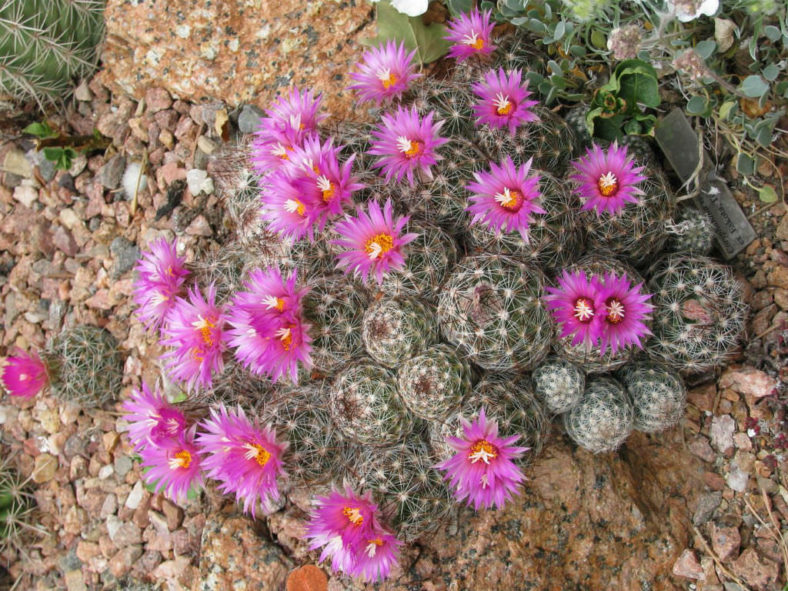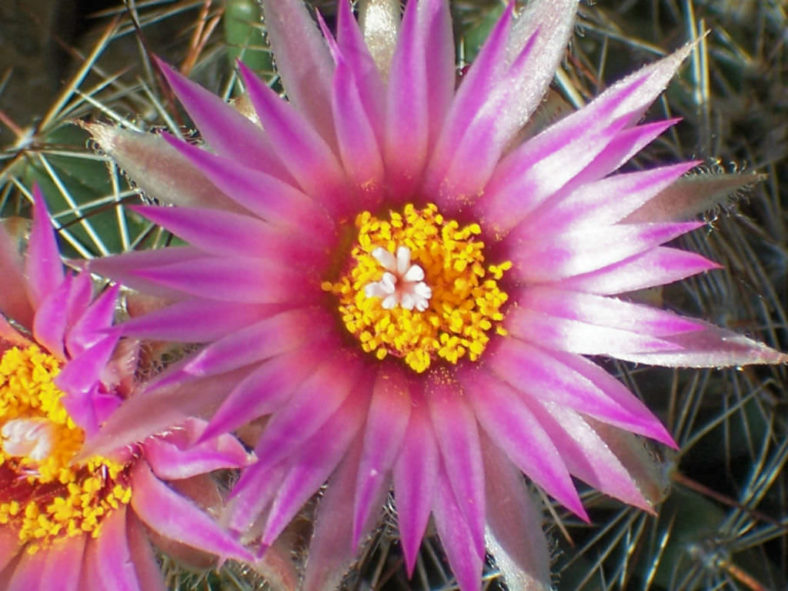Scientific Name
Escobaria vivipara (Nutt.) Buxb.
Common Name(s)
Beehive Cactus, Pincushion Cactus, Pink Pincushion Cactus, Purple Ball Cactus, Spinystar, Spinystar Cactus, Viviparous Foxtail Cactus
Synonym(s)
Cactus viviparus, Coryphantha vivipara
Scientific Classification
Family: Cactaceae
Subfamily: Cactoideae
Tribe: Cacteae
Genus: Escobaria
Etymology
The specific epithet "vivipara" (pronounced "vy-VIP-ar-uh") means "live-bearing" and refers to the tendency of this species to reproduce by producing offsets that can root and grow into new plants.
Origin
The native range of Escobaria vivipara extends from northern Mexico to the Canadian prairies.
Description
Escobaria vivipara is a small cactus with spherical to short, cylindrical stems with slightly grooved tubercles, each tipped with a moderately woolly areole from which the spines emerge. It can grow solitary or in clumps of up to 30 stems. The stems can reach a height of 8 inches (20 cm) and a diameter of 4.4 inches (11 cm). Each areole bears 3 to 14 central and 10 to 40 radial spines. The central spines are red or basally white and can measure up to 1 inch (2.5 cm) long, while the radial spines are white and can grow up to 0.9 inches (2.2 cm) long.
The flowers are pale rose-pink to reddish pink or magenta, sometimes with darker midstripes or shading to white or pale greenish. They are funnel-shaped, appear from the axils of tubercles near the top of the stems in summer, and can reach a length of 2.2 inches (5.5 cm) and a diameter of 2.7 inches (6.7 cm). The fruits are green, with exposed portions slowly turning dull brownish-red. They are ovoid to obovoid, and contain bright reddish-brown seeds, measuring up to 1.1 inches (2.8 cm) long and up to 0.8 inches (2 cm) in diameter..

Hardiness
USDA hardiness zones 4a to 10b: from -30°F (-34.4°C) to 40°F (4.4°C).
How to Grow and Care
Escobarias are very susceptible to rot and, therefore, require well-drained soil without any water excess or stagnation; it has been observed that the plants also suffer from environmental humidity, which should preferably remain very low (30-50%). Avoid watering during the winter, when the plant is dormant: watering Escobaria in cold environmental conditions will almost certainly lead to the death of the plant. The plants, whose growth is typically quite slow, perceive a significant temperature difference between night and day in the growing season. The average winter minimum temperature, in general, should not fall below 42°F to 46°F (6°C to 8°C) unless there are individual exceptions; adult plants can withstand very intense frosts, but only if the temperature rises again quickly.
The experienced grower knows well the difficulties of survival in this genus, which is certainly not one of the easiest to grow. The seed germination rate is lower than that of other genera. Other propagation methods are preferable, such as offsets or cuttings.
See more at How to Grow and Care for Escobaria.
Links
- Back to genus Escobaria
- Succupedia: Browse succulents by Scientific Name, Common Name, Genus, Family, USDA Hardiness Zone, Origin, or cacti by Genus
Photo Gallery
Click on a photo to see a larger version.

